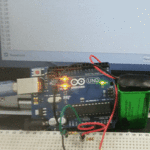البرمجة
ارفع الكود البرمجي للعبة دولار النينجا على لوحة الاردوينو باستخدام برنامج اردوينو IDE.
#include <LiquidCrystal_I2C.h> LiquidCrystal_I2C lcd(0x27, 16, 2); const int buttonPin1=1; const int buttonPin2=6; const int buzzer=7; unsigned long pts=0; //set buttonstates bool buttonState1=0; bool buttonState2=0; //random number for position of obstacles int randomNums[6]; //random number for number of obstacles int randomNum=0; //random number for position of pts int randomNums1[3]; //random number for number of pts int randomNum1=0; //start delay time, which decreases gradually unsigned int myDelay=500; //made this boolean to check if button2 is pressed because if it's pressed once in the first for loop i want obstacles not to be written until the end of it bool temp=0; //this variable stores the positions of the warrior while he shoots. there can be 16 positions because the warrior has 16 positions. int tempI[16]; //i use this boolean to check if the point is catched bool temp1=0; //use this variable to store the position of the catched point. it must be and array to store the position of all the points in one iteration of the first for loop. if it stored just one position, then the "old" point would come back in the new iteration int tempI1[3]; //use this variable to have a number of shots of the warrior, which is also the length of an array tempI int button2IsPressed=0; void setup() { // set up the LCD's number of columns and rows: lcd.begin(); // set buttonpin mode pinMode(buttonPin1,INPUT); pinMode(buttonPin2,INPUT); pinMode(buzzer,OUTPUT); lcd.setCursor(4,0); lcd.print("THE GAME"); lcd.setCursor(2,1); lcd.print("STARTS IN "); lcd.print("5"); delay(1000); lcd.setCursor(12,1); lcd.print("4"); delay(1000); lcd.setCursor(12,1); lcd.print("3"); delay(1000); lcd.setCursor(12,1); lcd.print("2"); delay(1000); lcd.setCursor(12,1); lcd.print("1"); delay(1000); lcd.clear(); } void loop() { here: randomNum=random(5); for(int i=0; i<randomNum; ++i){ randomNums[i]=random(16);} randomNum1=random(3); for(int i=0; i<randomNum1; ++i){ randomNums1[i]=random(16); } //i reset temp variable before every new for loop because the cycle of the moving warrior starts again temp=0; for(int j=0; j<3; ++j){ tempI1[j]=0; } button2IsPressed=0; //loop that writes dollar(warrior) on the lcd which jumps everytime button is pressed for(int i=0; i<16; ++i){ //pts must be written here because of the lcd.clear() below (pts wouldn't be written down the whole time otherwise) //i must check if pts is greater than 9 or 99 etc to know how many gaps i should leave for the number. the more points are collected, the smaller delay time is and the faster is dollar if(pts>9 && pts<20) {lcd.setCursor(14,0); myDelay=400; } else if(pts>19 && pts<30) { lcd.setCursor(14,0); myDelay=300; } else if(pts>29 && pts<50) { myDelay=200; lcd.setCursor(14,0); } else if(pts>=50){ pts=0; myDelay=500; lcd.clear(); lcd.setCursor(5,0); lcd.print("VICTORY"); tone(buzzer,262); delay(200); tone(buzzer,330); delay(200); tone(buzzer,392); delay(100); tone(buzzer,330); delay(100); tone(buzzer,392); delay(100); tone(buzzer,523); delay(200); noTone(buzzer); delay(3000); lcd.clear(); goto here; } else lcd.setCursor(15,0); lcd.print(pts); buttonState1=digitalRead(buttonPin1); buttonState2=digitalRead(buttonPin2); //setting obstacles if the warrior didn't shoot or he shot but he also jumped if(!temp){ for(int j=0; j<randomNum; ++j){ lcd.setCursor(randomNums[j],1); lcd.print("#"); } } //checking if the warrior had shot but there were obstacles before him, we want those obstacles to stay else{ for(int j=0; j<randomNum; ++j){ //i check only the tempI[0] position because that's the when the warrior shot for the first time and he removed all the remaining obstacles if(tempI[0]>randomNums[j]){ lcd.setCursor(randomNums[j],1); lcd.print("#"); } } } //setting pts if(!temp1){ for(int j=0; j<randomNum1; ++j){ lcd.setCursor(randomNums1[j],0); lcd.print("*"); } } else{ for(int j=0; j<randomNum1; ++j){ if(randomNums1[j]!=tempI1[j]){ lcd.setCursor(randomNums1[j],0); lcd.print("*"); } } } //if the button is pressed we set the cursor up (so that our warrior jumps) if(buttonState1==HIGH) {lcd.setCursor(i,0); tone(buzzer,131); delay(200); noTone(buzzer); } else lcd.setCursor(i,1); lcd.print("$"); //if button2 is pressed our warrior shoots. i had to put this loop here so that warrior shoots from his current spot and then continues to move. that's why delay time is 5 so that this loop finishes as soon as possible if (buttonState2==HIGH) { tone(buzzer,175); delay(100); noTone(buzzer); temp=1; //if the button1 is low then we remove all the obstacles. that's why the state if temp variable is changed if(buttonState1==LOW) { tempI[button2IsPressed]=i; } ++button2IsPressed; for(int k=i+1; k<16; ++k){ //if the buton1 is low then warrior shoots in the second row. otherwise it shoots in the first row if(buttonState1==LOW) lcd.setCursor(k,1); else lcd.setCursor(k,0); lcd.print("~"); delay(5); if(buttonState1==LOW) lcd.setCursor(k-1,1); else lcd.setCursor(k-1,0); lcd.print(" "); delay(5); } } delay(myDelay); lcd.clear(); //checking if the positions of the pts and the warrior are the same and if the button is pressed because then they collide and we gain 5 extra points for(int j=0; j<randomNum1; ++j){ if(i==randomNums1[j] && buttonState1==HIGH){ temp1=1; tempI1[j]=i; pts+=5; } } //checking if the positions of the obstacle and the warrior are the same and if the button1 is not pressed, then they collide and it is the end of the game for(int j=0; j<randomNum; ++j){ if(i==randomNums[j] && buttonState1==LOW && temp==0) { pts=0; myDelay=500; lcd.clear(); lcd.setCursor(6,0); lcd.print("GAME"); lcd.setCursor(6,1); lcd.print("OVER"); tone(buzzer,349); delay(200); tone(buzzer, 277); delay(200); tone(buzzer,220); delay(100); tone(buzzer,277); delay(100); tone(buzzer,220); delay(200); noTone(buzzer); delay(3000); lcd.clear(); //i must skip the for loop because otherwise the game would continue where it ended goto here; } //counting number of skipped obstacles and that would be our points else if(i==randomNums[j] && buttonState1==HIGH) ++pts; } } }
شرح الكود البرمجي
سنقوم في البداية باستدعاء مكتبة (LiquidCrystal_I2C.h) الخاصة بوحدة i2c والتي تحتوي على مجموعة أوامر برمجية نحتاجها في المشروع.
#include <LiquidCrystal_I2C.h>
نعرف عنوان وحدة i2c.
LiquidCrystal_I2C lcd(0x27, 16, 2);
نعرف المتغيرات الخاصة بالأزرار buttonPin1 تم ربطه بالمنفذ 1 و buttonPin2 تم ربطه بالمنفذ 6 ومصدر الصوت buzzer تم ربطه بالمنفذ 7.
const int buttonPin1=1; const int buttonPin2=6; const int buzzer=7;
ستكون الحالة الابتدائية لكل الأزارير =0.
bool buttonState1=0; bool buttonState2=0;
سيتم اختيار أماكن عشوائية لعلامة المربع على الشاشة الكرستالية.
//random number for position of obstacles int randomNums[6]; //random number for number of obstacles int randomNum=0;
وأماكن عشوائية لعلامة النجمة على الشاشة الكرستالية.
//random number for position of pts int randomNums1[3]; //random number for number of pts int randomNum1=0;
في الدالة ()setup ستستقبل الأزرار المدخلات والشاشة ومصدر الصوت للمخرجات.
ستحتوي الشاشة الابتدائية للعبة دولار نينجا على كلمة THE GAME ثم سيبدأ العدر التنازلي من 5 إلى 1 بعد ذلك ستبدأ اللعبة مباشرة.
void setup() { // set up the LCD's number of columns and rows: lcd.begin(); // set buttonpin mode pinMode(buttonPin1,INPUT); pinMode(buttonPin2,INPUT); pinMode(buzzer,OUTPUT); lcd.setCursor(4,0); lcd.print("THE GAME"); lcd.setCursor(2,1); lcd.print("STARTS IN "); lcd.print("5"); delay(1000); lcd.setCursor(12,1); lcd.print("4"); delay(1000); lcd.setCursor(12,1); lcd.print("3"); delay(1000); lcd.setCursor(12,1); lcd.print("2"); delay(1000); lcd.setCursor(12,1); lcd.print("1"); delay(1000); lcd.clear(); }
في الدالة ()loop ستبدأ النجوم وعلامة المربع بالظهور بأماكن عشوائية متفرقة.
وسيحاول اللاعب دولار القضاء على علامات المربع التي تعيق طريقه وذلك بالضغط المطوّل على الزر الأيمن في لوحة التجارب ويحاول أيضًا التقاط النجوم التي تزيد من رصيدعه وتزيد من فرصة فوزه وذلك بالاتجاه نحوها إما للأسفل أول للأعلى بالضغط المطوّل على الزر الأيسر في لوحة التجارب.
إذا لم يستطع الهروب وحدث تلامس بينه وبين علامة المربع ستنتهي اللعبة بخسارة اللاعب دولار وستظهر رسالة The game over.
void loop() { here: randomNum=random(5); for(int i=0; i<randomNum; ++i){ randomNums[i]=random(16);} randomNum1=random(3); for(int i=0; i<randomNum1; ++i){ randomNums1[i]=random(16); } //i reset temp variable before every new for loop because the cycle of the moving warrior starts again temp=0; for(int j=0; j<3; ++j){ tempI1[j]=0; } button2IsPressed=0; //loop that writes dollar(warrior) on the lcd which jumps everytime button is pressed for(int i=0; i<16; ++i){ //pts must be written here because of the lcd.clear() below (pts wouldn't be written down the whole time otherwise) //i must check if pts is greater than 9 or 99 etc to know how many gaps i should leave for the number. the more points are collected, the smaller delay time is and the faster is dollar if(pts>9 && pts<20) {lcd.setCursor(14,0); myDelay=400; } else if(pts>19 && pts<30) { lcd.setCursor(14,0); myDelay=300; } else if(pts>29 && pts<50) { myDelay=200; lcd.setCursor(14,0); } else if(pts>=50){ pts=0; myDelay=500; lcd.clear(); lcd.setCursor(5,0); lcd.print("VICTORY"); tone(buzzer,262); delay(200); tone(buzzer,330); delay(200); tone(buzzer,392); delay(100); tone(buzzer,330); delay(100); tone(buzzer,392); delay(100); tone(buzzer,523); delay(200); noTone(buzzer); delay(3000); lcd.clear(); goto here; } else lcd.setCursor(15,0); lcd.print(pts); buttonState1=digitalRead(buttonPin1); buttonState2=digitalRead(buttonPin2); //setting obstacles if the warrior didn't shoot or he shot but he also jumped if(!temp){ for(int j=0; j<randomNum; ++j){ lcd.setCursor(randomNums[j],1); lcd.print("#"); } } //checking if the warrior had shot but there were obstacles before him, we want those obstacles to stay else{ for(int j=0; j<randomNum; ++j){ //i check only the tempI[0] position because that's the when the warrior shot for the first time and he removed all the remaining obstacles if(tempI[0]>randomNums[j]){ lcd.setCursor(randomNums[j],1); lcd.print("#"); } } } //setting pts if(!temp1){ for(int j=0; j<randomNum1; ++j){ lcd.setCursor(randomNums1[j],0); lcd.print("*"); } } else{ for(int j=0; j<randomNum1; ++j){ if(randomNums1[j]!=tempI1[j]){ lcd.setCursor(randomNums1[j],0); lcd.print("*"); } } } //if the button is pressed we set the cursor up (so that our warrior jumps) if(buttonState1==HIGH) {lcd.setCursor(i,0); tone(buzzer,131); delay(200); noTone(buzzer); } else lcd.setCursor(i,1); lcd.print("$"); //if button2 is pressed our warrior shoots. i had to put this loop here so that warrior shoots from his current spot and then continues to move. that's why delay time is 5 so that this loop finishes as soon as possible if (buttonState2==HIGH) { tone(buzzer,175); delay(100); noTone(buzzer); temp=1; //if the button1 is low then we remove all the obstacles. that's why the state if temp variable is changed if(buttonState1==LOW) { tempI[button2IsPressed]=i; } ++button2IsPressed; for(int k=i+1; k<16; ++k){ //if the buton1 is low then warrior shoots in the second row. otherwise it shoots in the first row if(buttonState1==LOW) lcd.setCursor(k,1); else lcd.setCursor(k,0); lcd.print("~"); delay(5); if(buttonState1==LOW) lcd.setCursor(k-1,1); else lcd.setCursor(k-1,0); lcd.print(" "); delay(5); } } delay(myDelay); lcd.clear(); //checking if the positions of the pts and the warrior are the same and if the button is pressed because then they collide and we gain 5 extra points for(int j=0; j<randomNum1; ++j){ if(i==randomNums1[j] && buttonState1==HIGH){ temp1=1; tempI1[j]=i; pts+=5; } } //checking if the positions of the obstacle and the warrior are the same and if the button1 is not pressed, then they collide and it is the end of the game for(int j=0; j<randomNum; ++j){ if(i==randomNums[j] && buttonState1==LOW && temp==0) { pts=0; myDelay=500; lcd.clear(); lcd.setCursor(6,0); lcd.print("GAME"); lcd.setCursor(6,1); lcd.print("OVER"); tone(buzzer,349); delay(200); tone(buzzer, 277); delay(200); tone(buzzer,220); delay(100); tone(buzzer,277); delay(100); tone(buzzer,220); delay(200); noTone(buzzer); delay(3000); lcd.clear(); //i must skip the for loop because otherwise the game would continue where it ended goto here; } //counting number of skipped obstacles and that would be our points else if(i==randomNums[j] && buttonState1==HIGH) ++pts; } } }
بعد اكتمال عملية الرفع يمكنك بدء جو المتعة والتحدي مع دولار النينجا.
اختبر صحة خطواتك.
لا تنسَ فصل مصدر الطاقة بعد الانتهاء من استخدام النظام.






















